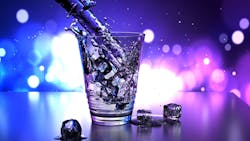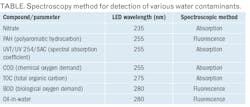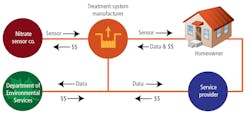The importance of clean water and water quality has come front and center in the current COVID-19 pandemic. Handwashing is recommended as the most effective way to eliminate viral particles from our hands, with a family of four needing 80 liters a day for handwashing alone. While this amount of water is taken for granted in many countries, it is a luxury in large parts of the world like India and China where water shortage due to contaminated water and drought is rampant. A key reason for water contamination is the discharge of untreated wastewater, as much as 80%, into drinking water sources which increases the concentration of bacteria and renders the water unfit for drinking, handwashing, or bathing.
Although water scarcity is less of an issue in developed countries, excess use of fertilizers in agriculture and the increasing number of onsite wastewater treatment systems has resulted in high concentrations of nitrate in groundwater and surface water, with impacts on human health and the environment. While this has primarily been a problem in the United States, it is also increasingly an issue in the European Union where Germany has had to deal with excess nitrate in groundwater.
Tackling water contamination requires the availability of affordable sensors that can be broadly deployed and enable regulatory authorities to track and identify sources of water contamination in lakes and rivers in real time, mitigate the effects immediately, and develop measures to prevent future contamination events.
Advanced sensing for water quality
While it is common knowledge that affordable sensors are key to improving water quality, such sensors were not possible prior to the development of high-light output, long-lifetime, deep ultraviolet (UV-C) LEDs. Indicators of organic contamination like ultraviolet transmittance (UVT), chemical oxygen demand (COD), biological oxygen demand (BOD), and concentration of compounds such as nitrate and polyaromatic hydrocarbons (PAH) in water can be measured by both chemical and optical methods.
Sensors using chemical methods are either expensive or require frequent calibration, replenishment of reagents, and frequent maintenance.
In the past, optical sensors were developed using mercury, deuterium, or xenon flash lamps. The emission of multiple UV-C wavelengths by these lamps enables simultaneous measurement of multiple parameters of water quality. However, the optical sensors are either expensive or require frequent light-source replacement, and have a relatively large footprint and power consumption. Thus, they are not suitable for distributed, real-time monitoring sensor networks.
UV-C LED spectrum leads benefits
A key advantage of UV-C LEDs over lamps is the near-monochromatic spectrum. This simplifies the optical design, eliminating mirrors, photodiode arrays, and shutters, while enabling the use of inexpensive photodiodes. In addition, power supply costs are lower. This reduces initial sensor cost by as much as 80%.
Furthermore, the ability of the LEDs to instantly reach full intensity means that the LED is turned on a few seconds prior to measurement (unlike, for example, deuterium or mercury lamps) and then turned off once the measurement is complete.
A related advantage of LEDs is that the repeated on/off operation does not reduce the LED lifetime, unlike mercury lamps. Consequently, sensors with UV-C LEDs can be operated in a duty cycle mode, which leads to replacement cycles of 5–10 years, unlike lamps that require replacement cycles as short as six months. This lifetime benefit further reduces cost of ownership for LED-based sensors.
Organic compounds and some inorganics such as nitrates are key determinants of water quality and absorb in the UV-C wavelength. The selection of the particular UV-C LED wavelength in these sensors is dictated by either regulatory standards or the closest available wavelength that matches the absorption characteristics of the compound of interest. Parameters such as UVT/COD and BOD are measured at 255 nm and 280 nm, respectively. Compounds such as PAH are measured at 255 nm and nitrate with newly available LEDs at 235 nm (see table).
While a majority of the measurements use absorption spectroscopy, a few like PAH and BOD use fluorescence spectroscopy. In fluorescence, the added benefit of high-performance UV-C LEDs is that their higher light output in a narrow wavelength range, compared to non-LED UV lamps, enables measurement of lower detection limits as well. Since the LED spectrum is near-monochromatic, the optical design is simpler, and inexpensive photodiodes can be used to measure the intensity of light absorbed or the intensity of the fluorescence emission. The simpler optical design reduces sensor costs by as much as 80% over UV lamp sensors.
It is clear that UV-C LED sensors are setting the standard in moving water quality away from measurement at discrete locations and times and toward continuous network monitoring. Current and emerging examples of water quality sensor networks include UVT monitoring of drinking water in multiple urban distribution systems in Europe, COD monitoring of treated wastewater in villages across rural China, and nitrate monitoring of surface water around the world.
UV-C LED use cases
LED-based water quality sensors are driving new use cases. While nitrate sensors were previously available and used in wastewater treatment, their cost and frequent maintenance requirements limited their adoption outside of central wastewater plants. The emergence of affordable UV-C-LED-based nitrate sensors enables decentralized wastewater treatment operators to remotely monitor the changes in influent nitrate concentration and optimize aeration, reduce carbon additions by as much as 50%, and decrease sludge hauling costs while meeting the low nitrogen requirements in the effluent. Another emerging application is in traditional agriculture where real-time nitrate monitoring is helping farmers reduce fertilizer costs and also demonstrate regulatory compliance in the effluent. In vertical farming, nitrate monitoring is enabling growers to address nitrate imbalance in the drain solution and reduce yield losses in real time, rather than wait for lab analysis — which can take up to a few days — or use electrochemical sensors that require frequent calibration, all while improving water and fertilizer use efficiency.
Monetizing big data from large-scale, remote real-time monitoring with LED-based sensors can also drive new business models. For example, more than 15 million US households rely on private wells for drinking water where nitrate contamination due to agriculture and septic tanks is a persistent problem, and there is no easy way to monitor nitrate other than sending samples for expensive lab tests. In one scenario, third-party home monitoring providers install nitrate sensors under a service contract. They can accrue additional revenue by providing the aggregated, anonymized data in local regions to relevant environmental authorities (the state Department of Environmental Protection — DEP, or Department of Environmental Services, for example), to take appropriate action (Fig. 1). This data otherwise would be impossible to obtain cost effectively by standard grab sampling from individual wells by local environmental authorities.
Similarly, more than 20 million households in the US have onsite wastewater treatment systems, and since these systems remove little of the nitrogen from the waste, they are being replaced by more expensive, taxpayer-subsidized systems. The newer systems are variable in their performance in the field and affected by homeowner actions such as dumping bleach down the drain. Currently, there is no way for homeowners, manufacturers, or regulatory authorities to monitor in real time whether the systems are functioning properly and meeting county regulations, other than periodic sampling (which is several hundred dollars per test). By installing nitrate sensors in the treatment system, manufacturers can use the data in multiple ways (Fig. 2):
- Monitor and share performance data to claim subsidies
- Alert service partners for service calls
- Sell data to local authorities in lieu of expensive grab sampling
Key to these business models is the availability of affordable sensors, robust sensors which require little or no service, and remote sensor management — all of which can simultaneously lower upfront costs to end users and enable reasonable payback periods for providers.
UV-C LEDs are making affordable water quality sensing a reality, on a scale much greater than what was possible in the recent past. This is enabling businesses to offer new services, governments to identify and respond to contamination events, users to track water quality in real time, and thereby cost-effectively improve environmental and health outcomes for people around the world.
Editor's note: Ultraviolet (UV) technology has been around for some time now, in uses as diverse as ink and materials curing, counterfeit detection, forensics, and of course, disinfection and sanitization. We’re pleased to cover this additional use for UV devices, as sensors, which is something we haven’t explored that deeply in LEDs Magazine. Interested in writing a contributed article on LEDs in a specific sensing application? E-mail an abstract to chief editor Maury Wright at [email protected].
Get to know our expert
HARI VENUGOPALAN is global director of new markets for Crystal IS, a specialist in ultraviolet (UV) LEDs and a subsidiary of Asahi Kasei Corporation.
For up-to-the-minute LED and SSL updates, why not follow us on Twitter? You’ll find curated content and commentary, as well as information on industry events, webcasts, and surveys on our LinkedIn Company Page and our Facebook page.








